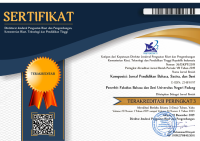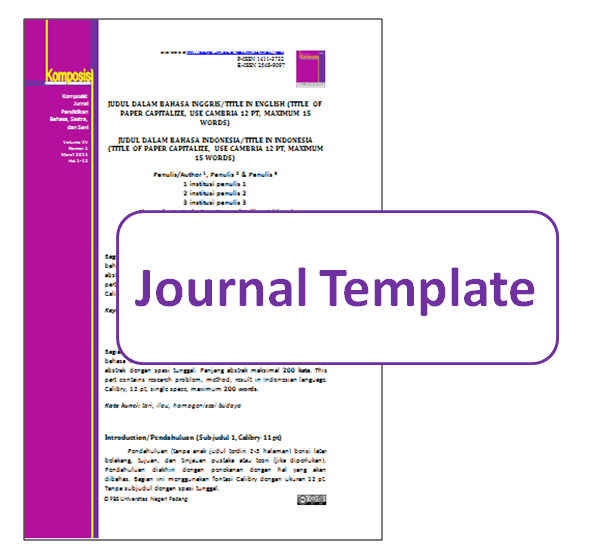Efektifitas dan Kepuasan Mahasiswa terhadap Model Pembelajaran Blended Learning Bahasa Mandarin di Masa Pandemi
Abstract
The transition of learning from offline to online during the Covid-19 pandemic initially presented many challenges. The limited ability of lecturers to master educational technology and the lack of experience in teaching online make lecturers tend to apply more virtual face-to-face methods as an alternative to learning in the classroom. However, implementing the virtual face-to-face method raises new problems, including students' declining psychological condition, health, and learning motivation. It becomes an in-depth evaluation for lecturers to design online learning that is more varied, interactive, and effective. Blended learning in this research is a blending of four online learning media: 1) virtual face-to-face with Zoom, 2) learning with Youtube videos, 3) learning with Edpuzzle, and 4) independent learning with assignments in LMS. This research aims to determine the effectiveness of blended learning and student satisfaction by combining four media in the online classroom. This research is an action research consisting of 3 cycles and carried out for two semesters for students of the Chinese Language and Culture Study Program, University of Al Azhar Indonesia, Class of 2019 and 2020. The results of this study include student responses about the learning media they like the most and most effective, the strengths and weaknesses of each media, and the level of effectiveness and student learning satisfaction with implementing blended learning.
Keywords
Full Text:
PDFReferences
Barlow, Alexis, Josephine Adekola, and Noreen Siddiqui. 2021. “Current and Future Online and Blended Learning Provisions.” JPAAP (Journal of Perspective in Applied Academic Practice) 9(2): 39–53.
Chang, Mei-mei. 2002. “Learning Foreign Language through an Interactive Multimedia Program: An Experimental Study on the Effects of the Relevance Component of the ARCS Model on JSTOR.” CALICO journal 20(1): 81–98. https://www.jstor.org/stable/24149610 (February 19, 2023).
Chen, Lijuan, Yuping Wang, and Claire Rodway. 2021. “Social Strategy Use in Online Chinese Learning.” https://doi.org/10.1080/09588221.2021.1880442 35(9): 2423–51. https://www.tandfonline.com/doi/abs/10.1080/09588221.2021.1880442 (February 17, 2023).
Cronje, Johannes C. 2020. “Towards a New Definition of Blended Learning.” 18(2): 114–21. www.ejel.org (January 13, 2022).
Dongping, Chen. 2020. “汉语国际教育网络语言学习的困境与出路 [The Predicament and the Way Out of Online Language Learning for Chinese International Education].” China New Telecommunications 22(20).
Geng, Ziyi, and Luoyi Cai. 2022. “适用于线上汉语教学的网络平台与工具评介——以北美线上汉语课堂为例 [A Review of Platforms and Tools for Online Chinese Teaching--Taking North American Chinese Classrooms for Examples].” Journal of International Chinese Education 01: 18–38.
Harsiwi, Udi Budi, Liss Dyah, and Dewi Arini. 2020. “Pengaruh Pembelajaran Menggunakan Media Pembelajaran Interaktif Terhadap Hasil Belajar Siswa Di Sekolah Dasar.” Jurnal Basicedu 4(4): 1104–13. https://jbasic.org/index.php/basicedu/article/view/505 (February 19, 2023).
Hermanto, Yustinus Budi, and Veronika Agustini Srimulyani. 2021. “The Challenges of Online Learning During the Covid-19 Pandemic.” Jurnal Pendidikan dan Pengajaran 54(1): 46.
Jamaluddin, Dindin, Teti Ratnasih, Heri Gunawan, and Epa Paujiah. 2020. “Pembelajaran Daring Masa Pandemik Covid-19 Pada Calon Guru : Hambatan, Solusi Dan Proyeksi.” Karya Tulis Ilmiah UIN Sunan Gunung Djjati Bandung: 1–10. http://digilib.uinsgd.ac.id/30518/.
Jianzhen, Yin, and Wu Sicong. 2020. “试论汉语国际教育网络教学资源的开发与设计 [On the Development and Design of Online Teaching Resources for Chinese International Education].” New Curriculum Research 27.
Jinsheng, Shi, and Wang Lufei. 2021. “新冠疫情背景下高校留学生线上汉语教学调查研究 (Investigation and Research on Online Chinese Teaching for International Students in Colleges and Universities under the Background of the Covid-19).” Language Teaching and Linguistic Studies 4: 23–33.
Juan, Su. 2020. “海外远程汉字教学模式分析 [Analysis of Overseas Distance Chinese Character Teaching Model].” Modern Society 21: 174–76.
Maciej Serda et al. 2019. “Blended Learning to Develop Learners’ Autonomy in Language Learning under Globalization: The Online Self-Learning Platform on Chinese Idioms” eds. G. Balint et al. Uniwersytet śląski 7(1): 343–54. https://repository.eduhk.hk/en/publications/blended-learning-to-develop-learners-autonomy-in-language-learnin (February 18, 2023).
Manurung, Purbatua. 2020. “Multimedia Interaktif Sebagai Media Pembelajaran Pada Masa Pandemi Covid 19.” Al-Fikru: Jurnal Ilmiah 14(1): 1–12. http://jurnal.staiserdanglubukpakam.ac.id/index.php/alfikru/article/view/33 (February 19, 2023).
Mischel, Leann J. 2018. “Watch and Learn? Using EDpuzzle to Enhance the Use of Online Videos:” https://doi.org/10.1177/2379298118773418 4(3): 283–89. https://journals.sagepub.com/doi/abs/10.1177/2379298118773418 (January 13, 2022).
Monica, Junita, and Dini Fitriawati. 2020. “Efektivitas Penggunaan Aplikasi Zoom Sebagai Media Pembelajaran Online Pada Mahasiswa Saat Pandemi Covid-19.” Jurnal Communio : Jurnal Jurusan Ilmu Komunikasi 9(2): 1630–40. https://ejurnal.undana.ac.id/index.php/JIKOM/article/view/2416 (January 13, 2022).
Mulyatiningsih, Endang. 2015. Modul Pelatihan Pendidikan Profesi Guru: Fakultas Teknik, Universitas Negeri Yogyakarta. Universitas Negeri Yogyakarta.
Mustafa, Pinton Setya et al. 2020. Metodologi Penelitian Kuantitatif, Kualitatif, Dan Penelitian Tindakan Kelas Dalam Pendidikan Olahraga. Malang: Fakultas Ilmu Keolahragaan Universitas Negeri Malang. http://repo.iainbatusangkar.ac.id/xmlui/handle/123456789/22504 (February 19, 2023).
Nacak, Ayşegül, Başak Bağlama, and Burak Demir. 2020. “Teacher Candidate Views on the Use of YouTube for Educational Purposes.” Online Journal of Communication and Media Technologies 10(2): e202003.
Oxford, Rebecca L. 2016. Teaching and Researching Language Learning Strategies : Self-Regulation in Context, Second Edition. Routledge. https://www.routledge.com/Teaching-and-Researching-Language-Learning-Strategies-Self-Regulation-in/Oxford/p/book/9781138856806 (February 17, 2023).
Qadriani, Nanda Lailatul. 2022. “Blended Learning, The International Chinese Learning Trend In Post-Pandemic Era.” Lingua Didaktika: Jurnal Bahasa dan Pembelajaran Bahasa 16(1): 44–53. http://ejournal.unp.ac.id/index.php/linguadidaktika/article/view/116661 (June 22, 2022).
Qadriani, Nanda Lailatul, Sri Hartati, and Anitasa Dewi. 2021. “Pemanfaatan Youtube Dan Edpuzzle Sebagai Media Pembelajaran Daring Berbasis Video Interaktif.” Jurnal Pemberdayaan Masyarakat Universitas Al Azhar Indonesia 4(1): 1. https://jurnal.uai.ac.id/index.php/JPM/article/view/841.
Rasheed, Rasheed Abubakar, Amirrudin Kamsin, and Nor Aniza Abdullah. 2020. “Challenges in the Online Component of Blended Learning: A Systematic Review.” Computers and Education 144(September 2019): 103701. https://doi.org/10.1016/j.compedu.2019.103701.
Sharma, Pete. 2010. “Blended Learning.” ELT Journal 64(4): 456–58. https://academic.oup.com/eltj/article/64/4/456/390082 (January 12, 2022).
Sudarsana, I Ketut et al. 2018. Teknologi dan Aplikasinya dalam Dunia Pendidikan Teknologi Sinkronus Dan Asinkronus Untuk Pembelajaran. http://jayapanguspress.org.
Thorne, Kaye, and David Mackey. 2003. Everything You Ever Needed to Know About Training. 4th ed. https://books.google.co.id/books?id=7_RyVw8MhZYC&printsec=copyright&redir_esc=y#v=onepage&q&f=false (January 13, 2022).
Tohari, H. (Hamim), N. (nFn) Mustaji, and B. S. (Bachtiar) Bachri. 2019. “Pengaruh Penggunaan Youtube Terhadap Motivasi Belajar Dan Hasil Belajar Mahasiswa.” Kwangsan 7(1): 286906. https://www.neliti.com/publications/286906/ (January 13, 2022).
Tomlinson, Brian, and Claire Whittaker. 2013. Blended Learning in English Language Teaching: Course Design and Implementation. London: British Council. www.britishcouncil.org (January 12, 2022).
Usman, Usman. 2019. “Komunikasi Pendidikan Berbasis Blended Learning Dalam Membentuk Kemandirian Belajar.” Jurnal Jurnalisa 4(1): 136–50.
Vargas-Urpí, Mireia, and Yanjun Xu. 2021. “Online Chinese Learning: A Case Study of the Use of YouTube Instructional Videos.” Chinese Language Teaching Methodology and Technology 4(2). https://engagedscholarship.csuohio.edu/cltmt/vol4/iss2/3 (February 17, 2023).
Widayati, Ani. 2008. “PENELITIAN TINDAKAN KELAS.” Jurnal Pendidikan Akuntansi Indonesia 6(1). https://journal.uny.ac.id/index.php/jpakun/article/view/1793 (February 19, 2023).
Wijayati, Primardiana Hermilia, Wafda Nabila Haqqie, and Aiga Ventivani. 2021. “PEMANFAATAN AKUN YOUTUBE BERKONTEN PEMBELAJARAN BAHASA MANDARIN DALAM LITERASI DIGITAL PADA ERA PANDEMI.” Lingua Franca:Jurnal Bahasa, Sastra, dan Pengajarannya 5(2): 121.
Yuming, Li et al. 2020. “新冠疫情下的汉语国际教育:挑战与对策”大家谈(上) [Teaching Chinese to Speakers of Other Languages under the COVID-19 Epidemic: Challenges and Countermeasures].” Language Teaching and Linguistic Studies 4: 1–11. https://kns.cnki.net/kcms/detail/detail.aspx?dbcode=CJFD&dbname=CJFDLAST2020&filename=YYJX202004002&uniplatform=NZKPT&v=IZ-AR4bih2uv3-WlV0CBI_1Lb4uuIiKkn8auP7qMxD1WDBIs8NmlFwfVZHAWNXpd.
Zhao, Shuwei. 2022. “The Construction of Chinese Virtual Learning Community in ZOOM: Based on the Teacher‐student Interaction.” International Journal of Social Science and Education Research 5(2): 135–42. https://www.airitilibrary.com/Publication/alDetailedMesh?DocID=P20190819001-202202-202201240001-202201240001-135-142 (February 17, 2023).
Zhiyong, Jiezhi. 2021. “新冠肺炎疫情背景下汉语国际教育探究 [Research on International Chinese Education under the Background of the Covid-19 Pandemic].” Journal Of Tianjin Foreign Studies University 28(1).
DOI: https://doi.org/10.24036/komposisi.v24i1.116548
Refbacks
- There are currently no refbacks.
Copyright (c) 2023 Komposisi: Jurnal Pendidikan Bahasa, Sastra, dan Seni

This work is licensed under a Creative Commons Attribution-NonCommercial 4.0 International License.
Komposisi: Jurnal Pendidikan Bahasa, Sastra, dan Seni, a peer-reviewed online journal in languages, literature, and arts education.
Printed ISSN 1411-3732, Online ISSN 2548-9097.
Currently, Komposisi: Jurnal Pendidikan Bahasa, Sastra, dan Seni is indexed by:
Published by:
Universitas Negeri Padang (UNP)
Address: Faculty of Languages and Arts (FBS) Universitas Negeri Padang.
Jl Prof. Dr. Hamka Air Tawar Barat, Padang - West Sumatera -Indonesia
Telp/Fax. +62751 7053363
Home page: http://ejournal.unp.ac.id/index.php/komposisi | e-mail:komposisi.fbsunp @ fbs.unp.ac.id | cc: havid_a @ fbs.unp.ac.id
slot resmi
situs toto
situs toto toto slot
Wanita Subang Beli mobil dari Nolimit city
Gatot kaca Buat TKW Jadi jutawan
Rahasia sukses bermain Mahjing wins
rahasia sukses bermain mahjong ways
div>












